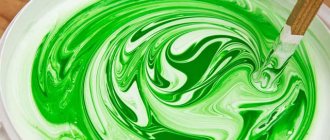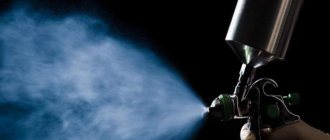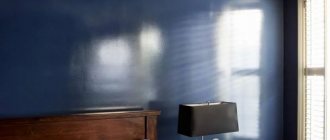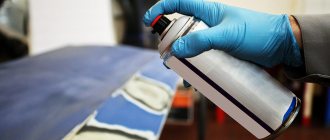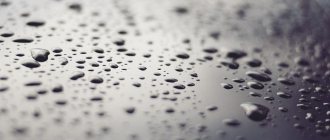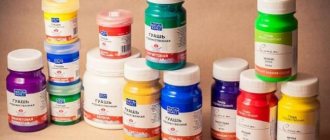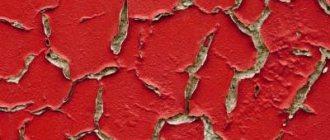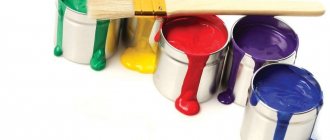Many users ask how to properly dilute water-based paint. This question comes up quite often. Your correct choice will guarantee a high-quality final result, as well as the durability of this coating. This way you will certainly avoid all the complications that may await you during construction work.
When to dilute
A composition whose component is water is called a water emulsion. If you apply the solution to the surface, you will notice that almost all the liquid quickly evaporates. The material gets its properties thanks to special fillers, which create a painted surface.
The protective layer can be obtained after a short period of time, after complete drying. The duration of this process also depends on the material on which it is applied.
Modern hardware stores offer a wide range of water-based paints. When choosing, it is better to focus on brands of well-known manufacturers who value their name and ensure the quality of their products.
Thick paint
If you opened a jar, and inside you saw a thickened composition or it was difficult to mix. In these cases, solvents must be used. But you should not overdo it, because then the composition will begin to flow, forming smudges. The protective layer will become thinner and will not be durable, and performance characteristics will sharply decrease.
Difficult to apply
Excessive density can be determined by a significant amount of the mixture that remains on the surface during painting. There are basically two methods of applying paint.
The first option is to use all kinds of brushes or construction rollers. In this case, the structure of the mixture should be sufficiently viscous. This will make it easier to manually process the ceiling or wall covering. The composition will not drain and will lay down in an even layer. If the paint is too liquid, it will be extremely difficult to apply.
The second option is spray guns or spray guns, which can be manual or electric. Using such devices, you can work even on very large areas. They will also make the whole process much easier for you and the paint will lay down perfectly evenly. A special feature of the tool is that it sprays the composition through a special nozzle under high pressure. That is why it is necessary to use a liquid consistency for devices. The dosage depends on the selected instrument model.
Violation of the shelf life
The composition will have to be diluted if the storage terms or conditions were violated. This can happen if you open a jar and then close it poorly. After a while, all dried material will be unusable. But sometimes it can be restored. To do this, you need to use special solvents, which we will discuss below. You can also dissolve the paint using PVA glue. But this is a rather expensive method.
Sometimes, after opening the can, it is discovered that the composition is very liquid. In this case, you can let it sit open for a while, without a lid, so that the excess liquid evaporates.
Adding a special hardener can also be a way out.
Coloring instructions
There are several ways to whiten a ceiling with water-based paint without streaks; various tools are used for this purpose.
Painting with a roller
You can get excellent ceiling coloring using a roller. This option is quite economical, and even a beginner can cope with the whole process. It is enough to follow the following tips, which explain how to paint step by step with this tool:
- Before painting, the room is prepared for work. It is advisable to glue the wall at the junction with the ceiling with paper tape so that the water emulsion does not get on the wall;
- Objects in the room should be covered with paper or film;
- Mix the material thoroughly, especially if colored dye is added to the white base;
- For the initial layer, a material of a thicker consistency is prepared than for subsequent layers;
- If small particles are found during mixing, you will have to strain the entire volume of paint through gauze so that the surface of the ceiling is free of flaws;
- A strip 8-10 cm wide is applied along the perimeter of the ceiling with a brush;
- The prepared material is poured into a container suitable for the size of the roller. For rolling, a piece of flat plywood is used, but it is more effective to use special containers equipped with a ribbed ditch, which allow you to evenly saturate the tool with paint;
- Painting is carried out from the corner in stripes 40-50 cm wide. The initial layer is applied parallel to the window, the subsequent one perpendicular. When working, maintain an inclination angle of 45 degrees. Painting of the next strip is carried out with an overlap on the previous one (about 100 mm is covered);
- It is necessary to take into account the drying time of the material (up to 20 minutes), so the entire amount of work should be done quickly, without being distracted by rest;
- The quality of painting can be checked in good lighting, and if daylight is not enough, use a powerful flashlight;
- Each new layer can be applied only after the previous one has completely dried, usually no earlier than 12 hours after completion of work;
- Irregularities are sanded with fine-grained sandpaper, after which another leveling layer of paint is applied.
Painting in 2 layers. Painting in 3 layers.
Spray painting
Using a paint sprayer allows you to get an even painting of the ceiling, while the worker makes a minimum of effort. The disadvantages of this technology include fairly high requirements for the power of the spray gun or spray gun.
An apparatus for spraying water-based paint must have a special compressor that is capable of creating the necessary pressure to force a fairly thick liquid through the nozzle.
How to paint a ceiling with water-based paint using a spray gun correctly:
- To facilitate this process, diluting the emulsion with water is often used. The water-based emulsion should be diluted in a ratio of one to one, as a result of which at least three layers of thinner paint will need to be applied to obtain a beautiful coating;
- Before starting work, it is recommended to adjust the sprayer on an unnecessary flat surface (a piece of plywood or drywall) to achieve the required coverage;
- Noticeable boundaries of the joining layers should be rubbed with fine sandpaper so that when applying the second layer this defect will be eliminated;
- Paint is sprayed at a distance of 50-55 cm from the surface to be painted; it is advisable to maintain a perpendicular inclination of the nozzle to the ceiling;
- The material is applied in squares, covering the surface first along, then across. You should move to the next area without delay to prevent excessive accumulation of material in one place. It is better not to completely paint the area, since this drawback can be eliminated by covering the defect with subsequent layers, and a thick layer will have to be cleaned and the entire volume redone.
Painting with a brush
It is possible to paint the ceiling using a brush, but the result will certainly be disappointing. It will not be possible to avoid stains and uneven paintability of the surface.
Repairs made with a brush are possible in non-residential premises, such as storage rooms, but you will have to put up with increased paint consumption, since drops of material, even with the most careful control, will flow from the tool onto the floor.
How to use water correctly
The main key to success is the choice of the most suitable thinner. Completely different substances are used for the process. Most often, ordinary water is used. This is the basis of this product.
If you have chosen water as a diluent, then you need to know exactly what parameters it must meet:
- First of all, you need to pay close attention to temperature readings . Liquid at room temperature is most suitable. If it is necessary to dilute paint for outdoor work, then the temperature of the liquid should be slightly higher than the ambient temperature. It is worth remembering that in hot weather it is necessary to add less liquid: the composition thickens more at low temperatures.
- It is best to dilute with distilled water . It is not necessary to buy such a liquid; you can get it at home; there are many ways to do this. The most popular method of purifying water is boiling it. After this, the liquid should settle.
You can not only make distilled water yourself, but also buy it at any hardware store. You can also buy this type of water at a pharmacy.
On the Internet you can find advice that it is better to dilute using all kinds of solvents. Similar compositions are often used for oil paint. It is worth noting that this absolutely cannot be done. This is completely wrong. If you add oil paint thinner, the mixture will simply curdle. And the worst thing is that such a reaction will not happen immediately. Cleaning the walls will take a long and painful time.
Decorative coating and its components
The paint is easy to apply on most surfaces, providing adhesion and sufficient durability. The problem is often the inappropriate consistency of the paint product. Thick paint creates an uneven layer; in some places the saturation is excessive, while in others the original color of the body is visible. The easiest way to solve the problem is to dilute the substance. Having decided what you can use to dilute acrylic paints and take a readily available liquid for dilution, it will not be difficult to create a high-quality coating.
Acrylic paints are easy to apply on most surfaces
The paint always contains 3 main components:
- Water.
- Pigment of the corresponding color.
- Connecting substances.
The most important component is an emulsion made of polymer materials, containing acrylic. High technical and performance qualities and ease of application allowed the paint to be used in many areas. Advantages of the composition:
- suitable for various facade works;
- helps in creating the interior;
- colors various materials;
- increased resistance to ultraviolet rays, this allows the product to be used outdoors;
- durability, the material does not fade, is resistant to peeling, destruction and mechanical damage;
- affordable price. Today, acrylic is classified as a low price category; it is always preferred to save money, although its characteristics provide decent quality;
- Application does not require professional skills; a person can do the coloring on his own.
Paint application does not require professional skills
Information on how to dilute paint for spray guns and other painting methods is applied to the container, but specialists are additionally based on current tasks. For the rough layer, a thick solution is often used, and the final coloring is performed with a thinner substance. Everything here is individual, but there are some norms that are not recommended to go beyond.
Basic proportions
If you are doing the work yourself and for the first time, then you may have some difficulties. It is especially difficult to calculate proportions. First of all, you need to look for specific proportions on the label, and only then test the consistency on a test plot and make adjustments if necessary.
Useful tips
In order to properly dilute water-based paint, you should listen to the recommendations of experts:
- In order to dilute the paint in the correct proportion, you need to add no more than 10% of any liquid. This is one of the main rules. You can see the official instructions on the product label. The manufacturer calculates the percentage volume based on the properties of the base itself, as well as the absorbency of the coloring matter.
- Breeding may be different, since the technology for performing the work also varies. For example, the first layer of paint should be the thickest and therefore it is necessary to add a minimum amount of distilled water to it. The third layer should lie well and therefore it should be as liquid as possible.
- It is not always necessary to add distilled water for dilution. It significantly increases the total consumption of the dye.
If you use a hand tool, then you can use undiluted paint.
Some craftsmen thin the paint to save money. At the same time, the decorative effect is significantly reduced. Laying with a spray gun from the foot is much easier, but this also increases the cost. Be extremely careful in this matter when hiring workers.
Adding a decorative element
Color is also not the last thing that can be added to a white water emulsion. You can give the room a fabulous atmosphere by mixing a decorative element into water-based paint. This additive can be purchased both on the market and in a construction supermarket. It can be sparkles or a mother-of-pearl effect.
When it is planned to make the surface bright and rich, decorative paint is applied over water-based paint. At the same time, do not forget that each subsequent layer can be painted on top of the previous one, after an hour - the interval must be observed so that the material has time to set.
For lovers of more muted and calm tones, a logical question arises: is it possible to make the room unusual, but not make the walls too bright? Yes, this can be done by simply adding a decorative element to the paint and color scheme. The mixing procedure is no different from the previous one: glitter is added to the pre-tinted mixture, and then it is all thoroughly mixed with a mixer and, if necessary, diluted with water.
How to dilute paint correctly
You don’t need to use any super complex equipment for this. You will need the simplest equipment:
- container for diluting the dye - it must be of a suitable size;
- mixer for more thorough mixing;
- construction spatula.
Step-by-step instruction:
- The dye must be carefully poured into a container that you have prepared in advance. Stir the paint constantly during the process.
- Water should be added in small portions. This way you can control the viscosity of the composition.
- It is necessary to mix the compositions thoroughly so that there are no lumps.
- The colorant must be added to the liquid already diluted.
You will learn how to properly mix dye with water-based paint in the following video.
Water-based paint is the choice of many professionals; it is popular due to its environmental characteristics, wide range of applications and low price. Beginning builders often have a question about how to dilute water-based paint so that it can be easily applied to the surface.
Regardless of whether it is needed for walls or ceilings, for interior decoration or outdoor use, you should not neglect the dilution step, otherwise you will not avoid the appearance of streaks, uneven layers or tubercles.
Dilution of water-based paint.
Working with water-based paint
How to dilute water-based paint? To achieve the desired paint consistency, the most common option is to add plain water. However, in order to avoid complications when working with a water-based composition, you need to know the correct dosage and dilution technology. For those for whom it is important that the surface being painted lasts for many years and looks perfectly smooth, this article will be of interest. It tells how to dilute water-based paint and how to do it correctly.
How to properly dilute water-based paint
Composition of water-based paint
Water-dispersion paint consists of tiny polymer particles suspended in an aqueous environment. In addition, it may contain up to 15 different additives, such as plasticizers, preservatives, thickeners, corrosion inhibitors, antiseptics and dispersants, as well as substances that increase structural viscosity and reduce foaming. The percentage and types of additives in water-based paint depend on the manufacturer, as well as on the main film former (copolymer) used. Depending on the purpose, versatate, acrylate, styrene acrylate, butadiene-styrene or polyvinyl acetate dispersion can be used as the main copolymer in water-based paint.
Apartment renovation: where to start?
How to dilute water-based paint
The role of the solvent is played by water purified from salts and minerals, and the filler is mica, talc, barite, calcite or chalk. As a rule, several fillers are used in one water-dispersion paint. In the production of white water-based paint, the pigment is zinc oxide or titanium dioxide. Manufacturers most often add ordinary chalk to cheap paints. Such water-based paint is often of poor quality, but is widely used in so-called budget construction work. Most manufacturers add a thickener to their paint, which most often uses carboxymethylcellulose, which is more familiar to consumers under the brand name CMC glue.
Advantages of water-based paint
The advantages of water-based paint can safely include the following aspects:
- When using paint, a positive microclimate is created in the room, as the painted surface continues to breathe.
- No special solvents are required; you can use water to achieve the desired consistency or wash your hands after work.
- There are no toxic elements, so the composition is considered as environmentally friendly as possible.
- The paint adheres perfectly to literally any surface, and the latter takes on a highly aesthetic appearance.
- The base composition can be painted in any color. This is done quickly using special pigments.
- The layer dries quickly, which is due to the ability of water to evaporate; therefore, one hour is enough for dust to no longer stick to the applied layer, and final hardening for some types of water-based paint occurs in just 12 hours.
- There is no unpleasant smell. If you compare it with oil paint, the difference is significant.
Some disadvantages of water emulsion
The disadvantages include the texture itself, there is no gloss, the painted surface quickly becomes dirty. It should be noted that this paint is very suitable for all porous surfaces. However, it does not adhere well to glossy surfaces. Because of this, it is customary not to use such paint for painting metals and plastic; the significant water content in the composition does not allow it to adhere well to smooth materials.
When to dilute
Water is the binding component of this paint and varnish material. Due to the water contained in the composition, after applying water-based paint to the surface, the liquid is partially absorbed and partially disappears during evaporation. The painting effect is provided by special fillers. A durable layer can be seen after the material has completely dried on the painted surface.
If, after opening a container of water-based paint, it is discovered that the material is liquid, it is enough to leave the can in the air for a short time. Excess liquid will evaporate and the material will be ready for use.
The decision about whether to add thinner to water-based paint should be based on thickness.
Thick paint
If, after opening the package, it is clear that the paint has thickened, it must be diluted with a solvent (water). The method for determining the consistency of paint material suitable for painting is simple.
The paint must be mixed with a wooden stick or brush.
If after removing the stick there is a lot of material left on it, it does not drain - you need to dilute it. In this case, the proportions recommended by the manufacturer must be observed, otherwise a durable coating will not work.
Difficult to apply
Experts advise adding liquid to water-based paint if it is difficult to apply to the surface or lays down in an uneven or too thick layer. To work with a brush or roller, the composition must be sufficiently viscous. When applied manually, paint that is too liquid can splash, run down the brush and prevent you from making an even layer.
On an industrial scale, spray guns or spray guns are used, which speeds up the painting process. In this case, the material must be liquid, otherwise it will not pass well through the spray nozzle and will not allow the job to be done well.
Using a spray gun for water-based paint.
Violation of the shelf life
If the jar was stored in incorrect conditions or after the initial opening it stood for a long time with the lid not tightly closed, the composition will begin to dry out. Dried paint can be revived by adding a solvent if it has not yet fully hardened.
Car paint
All automotive enamels are divided into several groups according to the concentration of components they contain:
- Highly filled.
- Medium filled.
- Low-filled (it is not recommended to dilute them too much before performing work).
This indicator determines how much solvent and other components were added by the manufacturer to the enamel so that it does not dry out during storage of the coloring composition. Such paints are marked accordingly and before applying them you should carefully read the instructions.
How much paint do you need to paint a car? This question is asked not only by those car owners who are painting their cars for the first time, but even by those who have already encountered this. You need to understand that this amount is individual and may vary in different specific cases.
After reading the information on how to dilute paint for a spray gun, you must learn all the intricacies of how a viscometer works. This is a special device that measures the viscosity of any paint and varnish materials.
dilute the paint
As a rule, it is inexpensive, but its benefits are invaluable. A viscometer is a small container whose opening is strictly calibrated. If it is necessary to measure the viscosity of different materials, viscometers are used, which have different volumes and hole diameters.
How many seconds does it take for the paint and varnish material to flow through the opening of the viscometer - this is the viscosity of the material being measured. When taking measurements, it is imperative to observe a certain temperature regime, otherwise the data may be inaccurate.
How to use water correctly
The easiest way to achieve the desired consistency of water-based paint is to dilute it with water, since this is used as a base.
To obtain a composition that will cover the surface well, it is necessary to use water of the following parameters:
- When work is carried out indoors, the liquid should be at room temperature. For outdoor work, the water temperature should be slightly higher than the ambient temperature.
- Water should not contain impurities. It is an excellent solvent; it may contain substances that the human eye will not notice. When adding untreated tap water, the coloring solution may slightly change color or change its properties for the worse. It is better to use distilled water. It can be purchased at construction or automotive stores. If it is not possible to stock up on purified water, you need to bring tap water to a boil, let it cool and settle.
How to dilute acrylic paint
Water-dispersion paints have become widespread in modern construction. These materials are popular when performing finishing work outside and inside the building. Acrylic-based paints, consisting of a binder component, coloring pigment and water, are especially in demand. After the material dries, the binder becomes transparent and invisible. The resulting coating is highly durable.
The need to thin acrylic paint may arise for two reasons: the paint is too thick or has dried completely.
How to thin thickened paint
Since acrylic paint is a water-dispersion material, ordinary water can be used to dilute it. The main thing is that it is clean and does not contain any solid impurities, chemical additives or other foreign substances. If the quality of tap water is sufficiently high, you can use it after letting it sit for several hours.
If you plan to use a paint gun during painting work, then it is recommended to dilute acrylic paint with special thinners, which are widely available in various construction specification stores. This is explained by the fact that for high-quality and uniform application of the coating with a spray gun, an optimal consistency of the paint poured into it is required.
When purchasing a solvent, you must take into account that they are produced separately for matte and glossy surfaces. The material should be selected according to the desired result.
Externally, the thinners are practically indistinguishable. The effect becomes noticeable only after the paint has completely dried. Glossy surfaces look smoother, while matte surfaces look warmer.
Some home craftsmen recommend using vodka with the addition of antifreeze as a diluent.
Thinning dried paint
If the acrylic paint in the jar has completely dried, you must first find out what caused it. There may be several reasons. For example, violation of storage conditions or expiration date. In these cases, it is better to throw away the paint. If it has dried due to natural evaporation of the liquid, it is recommended to perform the following sequence of actions:
- dried paint must be thoroughly crushed
- pour boiling water into the paint can to warm up the resulting mass
- until the boiling water has cooled, drain it and pour it again
- mix the paint
The result should be paint that is ready for application. If the mass turns out to be too thick, you need to add water or solvent to it.
Storage at negative temperatures leads to paint crystallization. Such material cannot be used.
To obtain a high-quality finishing material, it is necessary to maintain proportions when diluting the paint. They, in turn, depend on what specific tasks the painter faces. Professional builders use the following ratios:
1:0 – to create three-dimensional forms in order to implement design solutions, acrylic paint can be used without dilution,
1:1 - this proportion is most widespread and is most often used for finishing work,
1:2 – liquid paint for application on smooth surfaces to reduce dark shades,
1:5 - this composition is usually used to ensure that the finish penetrates deeper into the structure of the surface being painted (“shedding”).
To create smooth color transitions (gradients), even larger amounts of water can be added to the paint (for example, 1:15).
Sometimes proportions are selected experimentally. A small amount of paint is poured into three containers and thinner is added in ratios of 1:1, 1:2 and 1:3. Then apply brush strokes from each container to a surface similar to the one for which the paint is selected. After looking at the results, choose the optimal proportion.
Water (or thinners) is poured into the paint in small portions. For accurate dosing, it is recommended to use a measuring container. Along with the thinner, substances can be added to the paint to give the coating any special effects (for example, a neon glow).
In some cases, even completely dry acrylic paint can be made suitable for application. However, it’s better not to let things get to that point. To protect against drying out, it is necessary to close the jar tightly and ensure proper storage conditions.
How to dilute water-based dispersion paint
Before applying acrylic paint, it must be diluted. This can be done in several ways, depending on the degree of drying and the desired result.
Basic proportions
Before you start painting, you must study the label. Manufacturers clearly describe all the parameters of the material, leave recommendations on the scope of use of the product, methods of storage and dilution.
For beginners, the difficulty may lie in the fact that there is no clear rule governing the need to add water to the paint material. In each case, the composition is assessed after opening the package.
Sometimes it may turn out that there is no need to dilute the material, especially if the manual painting method is chosen.
Professionals advise applying the material to a small area, assessing its condition, and only then proceeding with dilution, based on the following proportions:
- the added liquid should not occupy more than 10% of the volume of the paint and varnish material;
- the percentage of added water is influenced by the painting technology: for the primer layer, from 5 to 8% of liquid is added, for the second - up to 3% of water, the finishing layer does not require dilution.
Preparatory work
Irregularities, stains, visible stains or other inclusions can ruin the overall impression of fresh painting. To prevent this from happening, proper preparation of the surface for coating is important.
First of all, you need to completely clean the surface of old coatings, be it wallpaper or paint. If the wallpaper is difficult to clean, you can help yourself by wetting it with water from a spray bottle. After the water is absorbed, the wallpaper will easily come off the walls or ceiling.
If the surface being prepared has various irregularities, the surface should be puttied/plastered and primed. Don't forget that you need to let the putty dry completely before painting.
The surface to be prepared should be freed from dust, stains and possible dirt particles; if necessary, the walls can be washed with a solution of water with the addition of a mild cleaning agent
After cleaning, it is important to wait until the surface is completely dry.
When the surface is as clean and dry as possible, you can proceed to the next and final stage before painting - primer. Most often, universal polymer compositions from various manufacturers are used for this stage. These types of primers are suitable for processing most types of materials, be it brick, concrete, cement, drywall.
It is better to start priming from the upper left corner, gradually moving to the lower right. Proper and high-quality priming of the surface will help ensure more reliable adhesion to the coating and will also remove residual dust if necessary. When applying the primer, you can use any convenient tool: a roller, a brush, even a cloth.
After such careful preparation, you can safely apply the paint without fear of peeling, unevenness and other unpleasant defects. Application is best done in two stages: first apply a thin base color, then fix it with another thin layer on top of the first. Between applications it is necessary to dry the layers thoroughly.
Useful tips
Before purchasing water-based paint, you need to pay attention to its shelf life. If it is nearing its end, it is better to choose a can from a later production. Then, if there is any unused material left after painting, it can be stored following the manufacturer’s recommendations.
You should not pour the material remaining after painting back into the common jar, this may affect its properties. It is better to use a clean plastic or glass container with a tight-fitting lid.
When purchasing, pay attention to the shelf life.
If the painting work is carried out by a hired worker, it is necessary to monitor the process of diluting the paint.
Some unscrupulous craftsmen dilute the paint too much, which makes it easier for them to apply each layer, but the decorative component suffers.
It would be a mistake to dilute water-based paint with solvents for oil paint or enamel. When such a solvent is added, the reaction does not occur instantly, but over time the coating will curdle.
Choosing paint for walls and ceilings
Whatever material the walls and ceilings are finished with (plaster, wallpaper, plasterboard or wood), you can always choose a paint that will give the walls a beautiful and bright look. Painting paints have different compositions and properties. Therefore, in order to choose the right paint, you need to consider what types of this material there are. When buying paint, first of all you need to make sure that it is suitable for covering the walls.
Types of paints
Painting paints are divided into the following types: oil, enamel, acrylic, water-dispersion, latex and others.
After application, it dries very quickly and does not have a strong unpleasant odor. Its main advantage is that dirt is poorly absorbed into its structure, so it is easy to clean off the painted surface.
Depending on the binding element included in the paint, water-based paints are divided into 3 types: latex, acrylic and water-soluble PVA-based. The latter are considered the cheapest; they have poor resistance to abrasion and moisture.
Most often, this paint is used to paint the ceiling. The peculiarity of this paint is that when adding pigment, only light tones of paint can be obtained. Color selection cannot be done on a computer, so the amount of pigment is determined manually. This paint cannot be used to paint bathroom walls and ceilings.
Acrylic paints have gained popularity due to the fact that they can be used to paint almost any walls and ceilings. The surface painted with acrylic paint is not afraid of wet cleaning.
The advantages of water-dispersion paint are: lack of unpleasant odor and quick drying.
Compared to the previous type, acrylic paint has a wider selection of colors. There are types of this material that are specifically designed for painting ceilings, for surfaces on which soot accumulates, for bathrooms, etc. The surface painted with this paint looks matte.
Latex paints have a number of advantages over the types described above - they are resistant to moisture, more durable, they can be applied to the surface in a thin layer (this is a very important property when painting a surface covered with wallpaper). Depending on the degree of gloss you need to achieve, manufacturers produce several types of latex paints
In addition to choosing the paint color, you need to pay attention to how safe this or that material will be for human health, because it will be used in a residential area. Paints that do not contain harmful components are considered environmentally friendly. They do not emit harmful fumes and do not cause allergies
They do not emit harmful fumes and do not cause allergies.
Silicone paints contain emulsified silicone resins. They appeared on the market relatively recently, but quickly became widespread. Silicone paints are very resistant to moisture and steam; they are successfully used when painting facades.
Oil paints contain artificial and natural oils and pigments. They have a long service life. The surface painted with oil paint is easy to clean. Disadvantages include a long drying time, a specific odor and peeling when exposed to moisture.
Decorative paints are used if there is a need to imitate any material: wood, stone, silk, gold, etc. Decorative paints can be water-based or contain polymer and mineral additives.
How to dilute paint correctly
For breeding, a set of tools available to everyone is used:
- a clean container for diluting the solution (a special painting tray, an old bucket or container from already used building materials);
- drill with mixer attachment.
Correct breeding occurs according to the following algorithm:
- It is necessary to pour the paint into the container, stirring as you go.
- Assess the volume of material in the container and prepare the water. It is added gradually, after each addition the solution is stirred with a drill, then its viscosity is determined.
- If lumps are visible in the solution, homogeneity has not been achieved, you need to continue stirring.
When the paint has reached optimal viscosity, you need to test it on a small area of the surface. If the composition meets all the parameters, lays down smoothly, and does not leave streaks, you can begin painting.
How and with what to dilute water-based paint? This question comes up quite often. The right decision is a guarantee of reliable and durable coating and the absence of complications during operation.
How to wash painted walls?
A surface painted with a water-dispersion material will not deteriorate from frequent washing if done correctly. Follow simple recommendations, otherwise there is a chance that the paint will lose its shine ahead of time and begin to become shiny.
To clean, you will need a soft bristle brush, detergent without abrasive particles and cotton wipes.
Having prepared everything you need, proceed as follows:
- Wet the wall generously with water and leave for 3 minutes.
- Apply detergent to the brush and scrub the wall, creating a rich lather.
- Rinse the brush under water and remove any remaining foam and dirt from the painted surface.
- Use a damp cloth to clean the wall, avoiding intense rubbing, and wait until it is completely dry.
When is it necessary to dilute water-based compositions?
Water emulsion is a water-based composition. It contains various fillers in the form of small droplets, which give the material its final properties. As the solution is applied to the surface, some of the liquid is absorbed and some evaporates. Due to the rapid removal of moisture, a protective layer is formed after a short period of time. Final drying depends on the surface material.
Diagram showing the process of water evaporation with the subsequent formation of strong bonds when applying water-based paint to the surface
Nowadays there are various versions of water-based (water-dispersed) paint on sale. Many manufacturers produce products under their own brands. Therefore, it is advisable to dilute the mixture, taking into account the individual characteristics of each variety in the following cases:
- If after opening it turns out that the solution is too thick, then it needs to be diluted. Determining that the consistency is not suitable for application is quite simple: to do this, mix the composition well. If a large amount of product remains on the stirring object and does not flow back, then the use of a solvent is necessary.
When diluting the paint, it is important not to overdo it, since the film thickness decreases when the composition is diluted, which means the performance characteristics of the coating are reduced.
- If the tools used make it difficult to apply the thickened composition. The process is carried out manually and mechanically:
- For the first option, brushes and rollers are used. Manual processing of walls and ceilings requires that the structure of the mixture be more viscous. This ensures the uniformity of the layer and the absence of drips that arise due to the fact that the paint is too liquid.
- The second method is to use a spray bottle. This device greatly simplifies the process and allows you to perform work over large areas. The peculiarity of the tool is that the coloring solution passes through the nozzle under pressure, due to which the suspension lies more evenly on the base. Therefore, to use a spray gun for water-based paint, the consistency of the composition must be liquid. Compared to the previous version, the viscosity decreases by 1.5–2 times. The exact proportions depend on the model of the instrument and the type of paint.
Types of water-based paint
Polyvinyl acetate structure
Can be used to work with porous materials: from plastered walls to wood and cardboard. The paint is based on PVA glue and the composition is revealed 100% only in dry rooms where the air temperature does not exceed 27 °C. Not suitable for outdoor use.
When the paint layer hardens, a semi-matte shade with a porous texture is formed. Because of this, the water in the paint evaporates quickly. Only if you follow the instructions from the paint manufacturer when adding water will you achieve a high-quality effect.
To use a roller or brush, the paint must have high viscosity
How to choose the right paint roller for painting
Acrylic water-based composition
When acrylic polymers are added to the paint, it acquires universal properties. This paint can be used not only on porous surfaces, but also on glass and metal. To thin the paint, use distilled water. Can be used for both internal and external work. The main rule is to read the manufacturer's instructions and recommendations.
Latex structure
Paint with absolutely any emulsion is very easy to make washable, just add latex. The substance forms a film on the surface that repels moisture. Latex does not affect the plasticity of the paint until the finishing layer of the surface being painted has completely hardened. A special crystalline structure is created that allows the surface to breathe and does not interfere with wet cleaning.
Using water to thin paint
The correct choice of thinner is the key to success. There are many tips and tricks for using different substances for this process. But the only correct solution is to use water, since it is the basis of the product.
For best dilution, the liquid must meet certain parameters:
- Temperature. The water should be at room temperature. If work is carried out outside, then a component is added to the façade solution that is slightly higher than the ambient temperature.
When deciding how much solvent to add to the paint, it is important to consider that at low temperatures the composition tends to thicken, and in hot weather it tends to become more liquid
- Presence of impurities. Water is an excellent solvent, so it may contain a large amount of unnoticeable substances that have a detrimental effect on the coloring solution (reduce its properties, change color). The best dilution occurs with distilled water. You can obtain purified liquid at home in different ways. If the impurities are too active, the diluent is brought to a boil and allowed to settle.
Distilled water can be found in almost any hardware or auto store, less often found in pharmacies
Attention! There is advice that dilution can be done using solvents used for enamel or oil paint. It is not right. If such a substance is added to a water-based emulsion, the mixture often simply curdles. However, the reaction may not appear immediately, which is misleading.
Which is better?
To choose a paint for painting, you need to know its characteristics and take into account both price and technical features. You need to know what surface is at the base for painting, whether you will pre-prime it, what are the technical characteristics of this surface, whether it is located outdoors or indoors, in what room, how much time you need to paint and for this surface to completely dry.
To paint indoors, you need to consider what needs to be painted - walls or ceilings or some wooden, metal, glass surfaces. The microclimate in a given room is also important. All types of water-based emulsions are suitable for dry rooms; you just need to keep in mind that polyvinyl acetate, although the cheapest, can turn yellow over time, mineral ones are easily erased upon contact, and acrylic, latex and silicone ones are quite expensive. It is best to paint concrete or plastered surfaces with silicate water emulsion. But it is not very suitable for wallpaper for painting; here it is better to use latex.
For wet rooms, acrylic, latex and silicone paints are best. The only disadvantages of latex are that it is afraid of low temperatures and is not vapor-permeable, does not protect against condensation, as well as mold and mildew. All of these types are highly expensive.
All types of paint are also suitable for ceilings. You just need to take into account that for rooms with high humidity it is better to use mineral, acrylic, latex or silicone. At the same time, acrylic and silicone do not flow when painted and are more durable, although more expensive.
Proportions
The biggest problems (especially for those who do all the work themselves and without experience) arise from proportions. The fact is that there is no clear correlation; you should be guided by the parameters that each specific manufacturer indicates on the label.
General recommendations look like this:
- Up to 10% liquid can be used for dilution. In this case, the exact parameters depend on the surface material and paint brand.
On the label, the manufacturer always indicates the permissible percentage of thinner to the total volume of paint
On a note! Excessive dilution is practiced by unscrupulous craftsmen. This makes it easier to lay each layer, reducing the decorative effect. In addition, if the purchase is not carried out by the owner of the apartment, this makes it possible to increase the estimate.
Varieties
Today on the shelves of construction stores you can find only four types of water-based paints
Their difference lies in the polymer that is included in the composition, so you need to choose with caution. Main types of water-based paints:
- Silicate;
- Acrylic;
- Mineral;
- Silicone.
Acrylic paint
This is perhaps the most popular and affordable type of water-based paint. The main component is acrylic resin, which is why the substance got its name. Manufacturers often dilute the composition with latex.
This solution allows acrylic paint to actively resist water and protect the surface. It turns out that the painted surface can be easily washed with liquid, without worrying that the paint will lose color, peel off and become unusable.
Manufacturers often indicate on the cans that the paint can withstand up to 5 thousand washing cycles with ordinary water. Using a double layer of a substance diluted with latex filler, you can easily mask cracks and depressions on the surface up to 1 mm deep. The price of one container is affected by technical characteristics (composition, filling, etc.).
Silicone paint
This paint contains silicone resin (the situation is the same as with acrylic). The cost of one can is slightly higher. The paint is excellent for treating mineral surfaces and can easily cope with cracks up to 2 mm deep.
Silicone water-based paint for walls and ceilings is classified as a vapor-permeable component. This property allows the substance to be applied to damp surfaces or surfaces exposed to increased moisture. Paint helps get rid of fungus.
Silicate paint
Silicate water-based paint is based on a mixture of different components: a solution of water, liquid glass and pigments of different colors. This type of finishing material has excellent vapor and air permeable characteristics and serves as excellent protection from the environment. This type of emulsion paint can easily last over 20 years.
Mineral paint
Almost all mineral water-based paints consist of slaked lime and sometimes cement. It is one of the best solutions for applying to ceilings and walls indoors. The main purpose of this dye is to work with surfaces made of concrete or brick. However, mineral paint has one serious drawback - a relatively short service life.
The water-based polyvinyl acetate composition is obtained by rubbing various pigments onto polyvinyl acetate emulsion paint. The advantage of this solution is that dilution with water allows you to work with the substance even indoors (completely safe and non-toxic).
How to dilute paint?
To dilute the selected material with water, there is no need to use complex equipment. To work you will need a simple set of devices:
- The paint is poured into the container. The process is carried out carefully, the composition is mixed a little.
- Water is added gradually. Even taking into account the proportions specified by the manufacturer, it is better to constantly check the viscosity.
- After adding each portion, everything is thoroughly mixed. If lumps are visible, it means that uniformity has not yet been achieved.
It should be borne in mind that the volume is affected by color, so it is added diluted in liquid.
